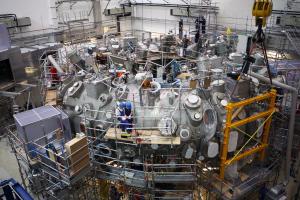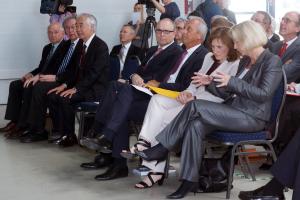Preparation for operation at Wendelstein 7-X
28 May 2014
-
Isabella Milch, IPP Garching
Wendelstein 7-X aims to show that, like tokamaks, stellarators are also a suitable concept for power plants.
After years of calculation, planning, component production and installation, the Wendelstein 7-X project entered a new phase in May 2014: at the Max Planck Institute for Plasma Physics in Greifswald, Germany, preparations started for operation of the world's largest fusion device of the stellarator type.
Wendelstein 7-X aims to show that, like tokamaks, stellarators are also a suitable concept for power plants. The complex structure of its magnetic field—the result of sophisticated optimization calculations—will be produced by a system of 50 unconventionally shaped superconducting magnet coils, the veritable technical core of the device.
Able to operate through discharges lasting half an hour, they will contribute to demonstrating the essential advantage of stellarators: continuous operation.
Companies from all around Europe produced the components for Wendelstein 7-X and numerous research facilities were involved in construction of the device.
In the audience (from left to right, front row): Prof. A. Smith, PPPL, USA; Dr. Richard Hawryluk, PPPL, USA; Prof. Osamu Motojima, Director-General, ITER Organization; Erwin Sellering, Prime Minister of Mecklenburg-Western Pomerania; Prof. Dr. Peter Gruss, President of the Max Planck Society; Prof. Dr. Sibylle Günter, Scientific Director of IPP; Prof. Dr. Johanna Wanka, Federal Minister of Education and Research. Also present (not pictured), the former Technical Director of Wendelstein 7-X, Rem Haange, currently head of the ITER Project Department.
At the beginning of May the cryostat was closed and the first pumps started up. An inauguration ceremony was held on 20 May in the presence of a large audience of national and international experts and guests of honour, including ITER Director-General Osamu Motojima, EU Energy Commissioner Günther Oettinger, and Johanna Wanka, German Federal Minister of Education and Research.
If all goes well, Wendelstein 7-X will produce its first plasma in about a year. "We all know the trend of global development, the hunger for energy of emerging economies and emerging countries, the finite nature of natural resources, the need to curtail climate change and to live the principle of sustainability," said Professor Johanna Wanka, Federal Minister for Education and Research, in her keynote speech. "So when we talk about energy, we need research that keeps all options open. And one of these options is nuclear fusion. Wendelstein 7-X is an important step forward allowing us to better evaluate the "fusion option."



